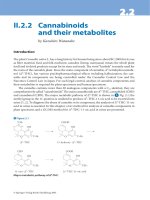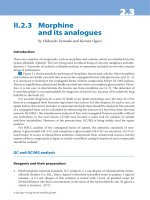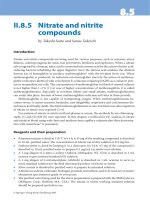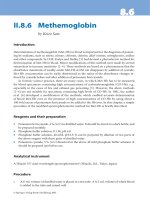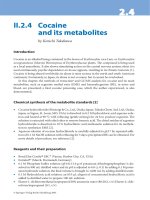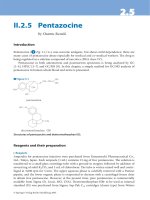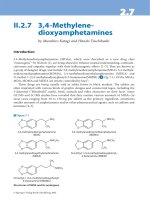Assessing childrens well being a handbook of measures ppt
Bạn đang xem bản rút gọn của tài liệu. Xem và tải ngay bản đầy đủ của tài liệu tại đây (13.94 MB, 325 trang )
TeAM
YYeP
G
Digitally signed by TeAM
YYePG
DN: cn=TeAM YYePG,
c=US, o=TeAM YYePG,
ou=TeAM YYePG,
email=
Reason: I attest to the
accuracy and integrity of
this document
Date: 2005.04.18
16:07:46 +08'00'
Assessing
Children's
Well-Being
A
Handbook
of
Measures
This page intentionally left blank
Assessing
Children's
Weil-Being
A
Handbook
of
Measures
Sylvie
Naar-King,
PhD
Deborah
A.
Ellis,
PhD
Wayne
State University
School
of
Medicine
Maureen
A.
Frey,
PhD,
RN
Children's
Hospital
of
Michigan
LAWRENCE
ERLBAUM
ASSOCIATES, PUBLISHERS
2004
Mahwah,
New
Jersey London
h
No
part
of
this book
may be
reproduced
in any
form,
by
photostat,
microfilm,
retrieval system,
or any
other means, without prior written permission
of the
publisher.
Lawrence Erlbaum
Associates,
Inc.,
Publishers
10
Industrial Avenue
Mahwah,
NJ
07430
Cover design
by
Sean Sciarrone
Library
of
Congress Cataloging-in-Publication Data
Child
assessment
in
pediatric
settings
:
handbook
of
measures
for
health care
professionals
/
[edited
by]
Sylvie Naar-King, Deborah
A.
Ellis, Maureen Frey.
p. cm.
Includes bibliographical references
and
index.
ISBN
0-8058-3173-8
(hbk.: alk. paper)
1.
Children—Medical examinations—Handbooks, manuals, etc.
2.
Children—Diseases—Diagnosis—Handbooks, manuals, etc.
3.
Child
development—Testing—Handbooks, manuals, etc.
4.
Medical screening—
Methodology—Handbooks, manuals, etc.
I.
Naar-King, Sylvie.
II.
Ellis,
Deborah
A.
III. Frey, Maureen
A.
RJ50.C479
2003
618.92W5—dc21
2002041680
Books
published
by
Lawrence Erlbaum Associates
are
printed
on
acid-free
paper,
and
their bindings
are
chosen
for
strength
and
durability.
Printed
in the
United States
of
America
10
987654321
To
our
families
and our
mentor,
Patricia
T.
Siegel
S.N.K.
and
D.A.E.
To
Jennifer,
Andy, Shannon,
and Sam
M.A.F.
This page intentionally left blank
Primary
Authors
Sylvie
Naar-King, Department
of
Psychiatry
and
Behavioral Neuro-
sciences, Wayne State University School
of
Medicine, Detroit, Michigan
Deborah
A.
Ellis, Department
of
Psychiatry
and
Behavioral Neuro-
sciences, Wayne State University School
of
Medicine, Detroit, Michigan
Maureen
A.
Frey, PhD, Department
of
Nursing
Administration,
Chil-
dren's
Hospital
of
Michigan, Detroit, Michigan
Contributing
Authors
Ronald
T.
Brown, PhD, College
of
Health Professions, Medical University
of
South Carolina, Charleston, South Carolina
Dennis Drotar, PhD, Department
of
Pediatrics, Rainbow
Babies
and
Chil-
dren's
Hospital
and
Case Western Reserve University School
of
Medi-
cine, Cleveland, Ohio
Sheila
M.
Eyberg, PhD,
ABPP,
Department
of
Clinical
and
Health Psy-
chology, University
of
Florida, Gainesville, Florida
Michelle
Macias,
MD,
Department
of
Pediatrics, Medical University
of
South
Carolina, Charleston, South Carolina
Jocelyn
McCrae, PhD, Department
of
Hematology/Oncology,
Children's
Hospital
of
Michigan, Detroit, Michigan
vii
viii
AUTHORS
Lilless McPherson
Shilling,
PhD, College
of
Health Professions, Medical
University
of
South Carolina, Charleston, South Carolina
Arthur Robin, PhD, Department
of
Psychiatry
and
Behavioral Neuro-
sciences,
Wayne State University School
of
Medicine, Detroit, Michigan
Conway
F.
Saylor, PhD, Department
of
Psychology,
The
Citadel, Charles-
ton, South Carolina
Patricia
T.
Siegel, PhD, Department
of
Psychiatry
and
Behavioral Neuro-
sciences, Wayne State University School
of
Medicine, Detroit, Michigan
Anthony
Spirito, PhD, Department
of
Psychiatry
and
Human Behavior,
Brown
Medical School, Providence, Rhode Island
Branlyn
E.
Werba, PhD, Department
of
Psychology, Children's Hospital
of
Philadelphia, Pennsylvania
Contents
Contributors
vii
Preface
xiii
Chapter
1
Health
Status
and
Quality
of
Life
1
Introduction
by
Dennis Drotar
1
Child Health
and
Illness
Profile
4
Child Health Questionnaire
7
Functional Disability Inventory
9
Functional Status
II (R) 11
Functional Status Questionnaire
13
Health
And
Daily Living—Youth Form
15
Pediatric Evaluation
of
Disability Inventory
17
Pediatric Quality
of
Life
Inventory
19
WeeFIM
21
Chapter
2
Adherence
27
Introduction
by
Maureen
A.
Frey
27
Daily
Phone Diary
29
Family
Responsibility Questionnaire
31
Medication Electronic Monitoring System
33
Medical
Compliance Incomplete Stories Test
35
Twenty-Four-Hour
Recall
Interview
37
Chapter
3
Pain
Management
41
Introduction
by
Jocelyn McCrae
41
Bieri
Faces Scale
43
Child-Adult Medical Procedure Interaction Scale-Revised
45
Children's
Hospital
of
Eastern
Ontario
Pain Scale
46
ix
X
CONTENTS
Neonatal Facial Coding System
48
Neonatal Infant Pain Scale
49
Observational Scale
of
Behavioral Distress
51
Oucher
53
Pediatric Pain Questionnaire
55
Waldron-Varni Pediatric Pain Coping Inventory
56
Chapter
4
Child
Behavior
61
Introduction
by
Arthur Robin
61
Hemophilia Clinic
62
Seizure Consult
63
Alternative Medicine Research Project
64
Behavioral
Assessment System
for
Children
65
Child Behavior Checklist
68
Conners'
Parent Rating Scale-Revised
72
Pediatric Behavior Scale
74
Pediatric Inpatient Behavior Scale
77
Pediatric Symptom Checklist
79
Piers-Harris
2 82
Self-Perception
Profile
for
Children
84
Chapter
5
Child Development
89
Introduction
by
Michelle Macias
and
Conway
F.
Saylor
89
Levels
of
Developmental Evaluation
90
Domains
of
Development
91
Selection
of
Instruments
for
Developmental Screening
91
Ages
and
Stages Questionnaires
94
Autism Behavior Checklist
96
Bayley
Infant
Neurodevelopmental Screener
98
Child Development Inventory
100
Denver
II 103
Developmental Indicators
for the
Assessment
of
Learning-3
107
Early
Screening
Profiles
109
Gilliam Autism Rating Scale
111
Chapter
6
Child Coping
115
Introduction
by
Anthony Spirito
115
Adolescent Coping Orientation
for
Problem Experiences
118
The
Children's
Coping Strategies Checklist
and the
How
I
Coped Under
Pressure
Scale
121
CONTENTS
xi
Coping Health Inventory
for
Children
124
Impact
on
Family Scale
126
KIDCOPE
128
Schoolagers' Coping Strategies Inventory
129
Chapter
7
Cognitions,
Attributions,
and
Attitudes
133
Introduction
by
Lilless McPherson Shilling
and
Ronald
T.
Brown
133
Child Attitude Toward Illness Scale
136
Children's Health Care Attitudes Questionnaire
138
Children's Health Locus
of
Control Scale
140
The
Health Self-Determinism Index
for
Children
142
Chapter
8
Environment
147
Introduction
by
Branlyn
E.
Werba
and
Sheila
M.
Eyberg
147
Family Adaptability
and
Cohesion Evaluation Scale
150
Family
Environment Scale
153
Family Inventory
of
Life
Events
156
Parents
of
Children with Disabilities Inventory
158
Parent-Child
Relationship Inventory
160
Parenting Stress Index
162
Symptom Checklist-90-R
and
Brief
Symptom Inventory
165
Chapter
9
Consumer
Satisfaction
169
Introduction
by
Patricia
T.
Siegel
169
Assessment
of
Parent Satisfaction
172
Child Perceptions
of
Specialty Care
173
Child Satisfaction Questionnaire
and the
Physician
Attribute Checklist
174
Client Satisfaction Questionnaire
and the
Service
Satisfaction Scale
177
Measure
of
Processes
of
Care
179
Metro Assessment
of
Child Satisfaction
181
Parent Perceptions
of
Specialty Care
183
Patient Satisfaction Questionnaire
185
Appendix
189
Functional Disability Inventory
191
Functional Status Questionnaire
195
PedsQL
199
xii
CONTENTS
WeeFIM
205
Family Responsibility Questionnaire
209
Medical
Compliance Incomplete Stories Test
213
Oucher
217
Pediatric Behavior Scale
221
Pediatric Symptom Checklist
227
Coping Health Inventory
for
Children
233
Children's
Coping Strategies Checklist
and How I
Coped
Under Pressure Scale
239
KIDCOPE
247
Schoolagers' Coping Strategies Inventory
251
Child Attitude Toward
Illness
Scale
259
Children's
Health Care Attitudes Questionnaire
265
Children's
Health Locus
of
Control Scale
273
Health Self-Determinism Index
for
Children
277
Assessment
of
Parent Satisfaction
285
Child Perceptions
of
Specialty Care
289
Parent Perceptions
of
Specialty Care
293
Author
Index
299
Preface
The
emphasis
on
collaborative management
of
children's health
has led
to
the
involvement
of
multiple
disciplines
in
pediatric health care. This
shift
has
resulted
in an
increasing
focus
on the
assessment
of
children's
functioning
across multiple domains.
The
Task
Force
on
Pediatric Educa-
tion
(1978)
noted several decades
ago
that
the
types
of
children's health
problems that
are
reported
in
pediatric settings include developmental,
behavioral, psychological,
and
educational difficulties,
as
well
as
those
related
to
their physical health. While attention
to
assessment issues
in
behavioral
pediatrics
has
historically lagged behind that given
to
inter-
vention
and
treatment,
the
field
has
reached
a
point
in its
maturity where
numerous measures
are
available
for the
assessment
of
infants, children,
and
adolescents.
The
goal
of
this volume
is to
provide
a
single source
reference
to key
screening instruments
for
clinicians
and
researchers
who
work with pedi-
atric
populations. Practitioners with
a
variety
of
backgrounds, including
physicians, social workers, nurses,
and
psychologists,
are
increasingly
using standardized measures
and
should
find
this
book useful
in
select-
ing an
appropriate screening tool.
The
volume
is
also intended
to
serve
as
a
comprehensive guide
for
study instrumentation
for
researchers.
Although other overviews
of
assessment measures
are
available, they
tend
to be
more circumscribed
in
nature (i.e., overviews
of
family
assess-
ment measures)
and do not
cover
the
full
range
of
areas that child health
care
professionals
may
need
to
assess.
The
areas targeted
by
this volume were chosen
to
cover
the
range
of
assessment issues
faced
by
child health clinicians
and
researchers, includ-
ing
health status
and
quality
of
life,
adherence
to
medical regimen, pain,
development, behavior,
children's
coping
and
cognitions,
family
func-
tioning,
and
consumer satisfaction.
Each
chapter begins with
an
expert
overview
of the
theoretical construct being measured,
and any
special
concerns.
Following
the
overview,
key
measures
are
reviewed.
xiii
xiv
PREFACE
It
should
be
noted that only quantitative measures with some evidence
of
adequate psychometric properties were considered
for
inclusion
in the
volume;
qualitative
measures
and
those
with minimal data
regarding
psychometrics were
not
presented.
In
general, Mash
and
Terdal's
(1990)
criteria
for
judging
the
utility
of
behavioral pediatric measures guided
the
selection
of
measures
for
inclusion.
They
recommend that measures
should
be
appropriate
for use in
health
care
settings,
have both
a
health
and
a
systems orientation, have
a
developmental perspective,
and be
effective,
time
efficient,
and
economical. Finally, assessment tools were
required
to be
general enough
to be
appropriate
for
both
the
general pedi-
atric
and
chronically
ill
populations. Although disease-specific measures
are
not
reviewed
in
detail,
a
reference
table
of
available disease-specific
measures
is
included
at the end of
applicable
chapters.
The
review
of
each measure
is
organized
in the
following
format.
First,
the key
reference
and
information
on how to
obtain
the
measure
are
pro-
vided. Second,
a
general statement about
the
purpose
of the
measure
and
a
more detailed description
of the
measure
are
presented.
A
discussion
of
any
standardization procedures, normative data,
or at a
minimum
a de-
scription
of the
sample used during instrument development
follows.
Reliability
and
validity
are
then evaluated. Reliability includes both
internal consistency
and
test-retest reliability. There
are
numerous terms
used interchangeably
to
describe validity.
For
consistency, three general
categories
of
validity that subsume
all
proposed
forms
of
validity
are
con-
sidered (Kaplan, Bush,
&
Berry,
1976):
content
validity,
criterion
validity,
and
construct
validity.
Content validity indicates whether
the
items that
make
up the
measure adequately represent
the
domain they
are
sup-
posed
to
sample.
Face
validity,
a
term that
refers
to
whether
the
item
appears
to
relate
to the
domain measured,
is
only
one
component
of
con-
tent validity.
Specific
procedures, such
as
expert review
and
interviews
with target subjects,
are
necessary
to
fully
ensure content validity.
Criterion validity
refers
to the
extent
to
which scores
on the
measure
are
related
to
scores
on
other relevant instruments that
are
thought
to
accurately
reflect
the
domain
of
interest.
The
scores
may
relate either con-
currently
(measured
at the
same
time) or
predictively (measured
at a
later
time).
Empirical
or
statistical validity
are
other terms that have been used
interchangeably with criterion validity.
Finally, construct validity
refers
to the
extent
to
which
a
measure truly
assesses
the
theoretical construct
it is
designed
to
measure. Instrument
developers
often
use
factor
analytic techniques
to
demonstrate construct
validity. Convergent
and
divergent validity assess statistical relation-
ships
between
the
measure
and
other measures assumed
to be
similar
to
or
different
from
the
construct
and are
additional
forms
of
construct
validity.
PREFACE
XV
The
presentation
of
each measure ends with
a
summary
of
strengths
and
weaknesses that synthesizes
the
previous information,
and
empha-
sizes applicability
to
pediatric
settings.
Additional relevant
references
are
also
included. Finally, each author
of a
measure
was
sent
a
copy
of the
report
and
offered
an
opportunity
to
respond. Their comments,
if
any,
are
included
at the end of the
review.
Measures
that were
not
copyrighted
or
those that
the
authors gave per-
mission
to
reproduce
are
included
in an
appendix.
We
would like
to
thank
the
contributors
to
this
volume
for
their
patience
and
coopoeration
in the
process
of
putting together this
refer-
ence
guide
in a
timely manner,
and for
providing
the
necessary theoreti-
cal
framework.
We
give special thanks
to Dr.
Michele Ondersma
for her
assistance with
the
initial
groundwork
for
this
volume.
We
would also
like
to
thank
our
editor, Susan Milmoe
for her
patience
and
guidance.
Finally,
we
would like
to
thank
the
staff
of the
Children's Hospital Med-
ical
Library
as
well
as
several assistants (Eboni
Black,
Jolene Daniel,
and
Eileen
Mitchell)
for
their assistance with
the
extensive research necessary
for
this type
of
work.
REFERENCES
Kaplan,
R. M.,
Bush,
J. W., &
Berry,
C. C.
(1976). Health
status:
Types
of
validity
and the
index
of
well-being.
Health Services Research,
11,
478-507.
Mash,
E. J., &
Terdal,
L. G.
(1990).
Assessment strategies
in
clinical
behavioral pediatrics.
In A. M.
Gross
& R. S.
Drabman
(Eds.),
Handbook
of
clinical behavioral pediatrics
(49-79).
New
York:
Plenum Press.
Task
Force
on
Pediatric
Education.
(1978).
The
Future
of
Pediatric Education.
Evanston,
IL:
American
Academy
of
Pediatrics.
This page intentionally left blank
1
Health
Status
and
Quality
of
Life
Dennis
Drotar
Case
Western Reserve University School
of
Medicine
INTRODUCTION
Chronic
health conditions that
affect
children represent
an
important
and
prevalent
public health problem (Newacheck
&
Taylor, 1992) that
can
disrupt
children's
functioning
and
activities (Newacheck
&
Halfon, 1998)
and
increase family burden (Drotar, 1997).
In
recent years, advances
in
medical
treatment have prolonged
the
lives
of
children with conditions
such
as
cancer
and
very
low
birth weight
and
have necessitated increased
attention
to the
assessment
of
their functioning
and
adaptation. Studies
of
the
long-term outcomes
of
children with chronic health conditions place
a
primary emphasis
on
assessment
of
functioning (Thompson
&
Gustafson,
1996).
As
interventions
are
developed
to
enhance
the
func-
tioning
and
adaptation
of
children with chronic
illness,
reliable
and
valid
measures
of
functional outcome become increasingly important (Bau-
man, Drotar, Perrin, Pless,
&
Leventhal, 1997).
For all the
aforementioned
reasons,
the
measurement
of
children's health status
and
quality
of
life
has
assumed
increased importance (Spieth
&
Harris,
1996).
Health status
refers
to a
description
of the
child's
overall level
of
health
that includes
the
severity
of the
illness. Quality
of
life
(QOL)
refers
to
functional
effect
of an
illness
as
perceived
by the
child
or
others
who are
knowledgeable about
the
child, such
as
caretakers (Spilker,
1990).
One
advantage
of the
construct
of QOL is the
fact
that
it is
comprehensive
and
measures
well-being
in
multiple
domains
such
as
physical,
mental,
and
social (WHO, 1948).
1
2
NAAR-KING,
ELLIS,
FREY
Health status
and QOL
assessments have several important appli-
cations.
One of
these
is the
ability
to
provide
a
comprehensive description
of
children's health
status,
which
can
have multiple purposes.
For
exam-
ple, assessments
can
provide descriptive information
on
current health
status, comparison
of
patients
at
different
disease stages, evaluation
of
the
efficacy
of
different
treatment protocols,
and
assessment
of the
child's
progress over time
in
response
to
medical treatment.
A
second application
is the
identification
of
acute dysfunctions,
chronic
dysfunctions,
or
both following
an
illness
or
treatment. This
is an
emerging problem among long-term survivors
of
illnesses such
as
cancer,
and
individuals
who are at risk for the
development
of
psychological dif-
ficulties
(Eiser,
1995; Mulhern
et
al., 1989).
QOL
assessment
can be
used
to
identify
children
with
a
chronic
illness
who may be at
risk
for
developing
future
psychological, physical
difficulties,
chronic symptoms,
or all of
the
aforementioned.
A
third application
of
measures
of
health status
and QOL is the
evalu-
ation
of
treatment
efficacy
and
clinical decision making. Traditionally,
health
outcome indicators have included information
on
mortality, mor-
bidity, hospital re-admission, re-treatment rates,
the
results
of
laboratory
and
other diagnostic
tests,
complications,
or all of the
above (Bowling,
1995).
Furthermore, assessments
of QOL
that
are
potentially sensitive
to
morbidity
associated with alternative treatments
are
necessary
to
docu-
ment
the
costs versus
benefits
of
available treatments (Eiser, 1995).
By
providing information about
patients'
subjective experience
and
morbid-
ity
associated with
different
treatments,
QOL
measures
can
also
facilitate
the
clinical decision making
in
deciding between alternative treatments.
Finally,
measures
of
health status
and QOL
describe
the
substantial vari-
ations
in
response
to
treatment
and
long-term prognosis within popula-
tions
of
children with chronic
illnesses.
Research
is
needed
to
develop
and
support
the
various applications
of
health
status
and QOL
assessments
in
children
and
adolescents.
In
partic-
ular, research
is
needed
to
document
the
utility
and
validity
of
measures
of
health status
and QOL in
clinical decision making, that
is, to
answer
questions such
as: How can
practitioners utilize assessments
of
health sta-
tus and QOL in
making treatment-related decisions
and
assessments?
How do
health status
and QOL
measures improve
efficiency
of
assess-
ment
and
clinical decision making?
Another
area
of
needed research concerning clinical application
involves
the use of
health status
and QOL
measures
to
evaluate
the
impact
of
managed care
and
health services
on
children's health
and
well-
being. Measures
of
health status
and QOL
have
the
potential
to
provide
valuable
data that
can be
utilized
to
evaluate
the
impact
of
comprehen-
sive
health
care
for
children
with chronic
health
conditions.
1.
HEALTH
STATUS
AND
QUALITY
OF
LIFE
3
Over
and
beyond research related
to
clinical applications
of
measures
of
health status
and
QOL, more basic research questions need
to be
addressed (Drotar,
1998).
Developmental research
has
underscored sig-
nificant
differences
in how
children
of
different
ages appraise their health
(Tinsley,
1992).
Research
is
needed
to
document
the
impact
of
develop-
mental
differences
in
children's perceptions
of
their health status
and
QOL
across various ages.
Research
is
also needed
to
document changes
in
perceptions
of
health status
and QOL
that occur
in
response
to
specific
developmental stages
(e.g.,
adolescence). Studies that describe
differ-
ences
in the
perceptions
of
health status
and QOL
among children, ado-
lescents,
and
parents
from
different
cultural groups
and
families
from
dif-
ferent
economic levels
and
structure would
be
highly desirable.
Because
it
is not
always possible
to
obtain reports
from
parent
and
child, research
is
needed
to
identify
domains
of
health status
and QOL for
which
a
par-
ent's
proxy report
is
sufficient
versus those
for
which
a
child's
report
supplies unique information. Other unanswered questions concerning
informants' reports that should
be
addressed
in
future
research concern
the
differential
validity
of
child versus parent reports
of
health status
of
QOL
for
various research questions
and
outcomes. Finally,
the
clinical
significance
and
validity
of
discrepancies
in
parents'
versus children's
perceptions
of
health status
and QOL
should
be
described (Drotar,
1998).
In
order
to
address these potential clinical applications
and
research
questions,
researchers
and
practitioners
who are
interested
in
measure-
ment
of
health status
and QOL
require access
to
these constructs. Such
access
is
especially important because many
of the
measures
of
health sta-
tus and QOL are
relatively new.
The
authors
of
this volume provided
an
important service
to
potential users
of
these instruments
by
summarizing
information
concerning available measures
of
health status
and QOL in a
succinct,
user-friendly
format.
REFERENCES
Bauman,
L. J.,
Drotar,
D.,
Perrin,
E.,
Pless,
F. B., &
Leventhal,
J.
(1997).
A
review
of the
effects
of
psychosocial interventions
for
children with chronic health conditions.
Pedi-
atrics,
100,244-251.
Bowling,
A.
(1995).
Measuring
disease:
A
review
of
disease-specific
quality
of
life
measurement
scales.
Philadelphia: Open University Press.
Drotar,
D.
(1997).
Intervention research: Pushing back
the
frontiers
of
pediatric psychol-
ogy.
Journal
of
Pediatric
Psychology,
22,
593-606.
Drotar,
D.
(Ed.).
(1998).
Measuring
health
related
quality
of
life
in
children
and
adolescents:
Implications
for
research
and
practice.
Mahwah,
NJ:
Lawrence Erlbaum Associates.
Eiser,
C.
(1995).
Choices
in
measuring
quality
of
life
in
children
with
cancer:
A
comment.
Psychooncology,
4,121-131.
Mulhern,
R. K.,
Horowitz,
M. E.,
Ochs,
J.,
Friedman,
A. G.,
Armstrong,
F. D.,
Copeland,
D.,
4
NAAR-KING, ELLIS,
FREY
&
Kun,
L. E.
(1989).
Assessment
of
quality
of
life
among pediatric patients with cancer.
Psychological
Assessment,
1,130-138.
Newacheck,
P. W., &
Halfon,
N.
(1998).
Prevalence
and
impact
of
disabling chronic condi-
tions
in
childhood.
American
Journal
of
Public Health,
88,
610-617.
Newacheck,
P. W., &
Taylor,
W. R.
(1992).
Childhood chronic illness: Prevalence, severity,
and
impact.
American Journal
of
Public Health,
82,
364-371.
Spieth,
L. E., &
Harris,
C. V.
(1996). Assessment
of
health related quality
of
life
in
children
and
adolescents:
An
integrative review.
Journal
of
Pediatric Psychology,
21,175-193.
Spilker,
B.
(1990).
Quality
of
life
assessments
in
clinical trials.
New
York:
Raven Press.
Thompson,
R. J., &
Gustafson,
K. E.
(1996).
Adaptation
to
chronic
childhood
illness.
Washing-
ton,
DC:
American Psychological Association.
Tinsley,
B. J.
(1992).
Multiple influences
on the
acquisition
and
socialization
of
children's
health
attitudes
and
behavior:
An
integrative review.
Child
Development,
63,1043-1069.
World
Health Organization.
(1948).
Constitution
of
the
World
Health Organization.
Geneva,
Switzerland:
Author.
CHILD HEALTH
AND
ILLNESS PROFILE
Source
Starfield,
B.,
Riley,
A. W.,
Green,
B. F.,
Ensminger,
M. E.,
Ryan,
S. A.,
Kelleher,
K.,
Kim-Harris,
S.,
Johnston,
D., &
Vogel,
K.
(1995).
The
adoles-
cent
&
child health
and
illness profile:
A
population-based measure.
Med-
ical
Care,
33,
553-556.
Availability
From
the
assistant
to the first
author.
The
Johns Hopkins University
School
of
Hygiene
and
Public Health, Department
of
Health Policy
and
Management,
624 N.
Broadway, Baltimore,
MD
21205.
The
measure
is
copyrighted.
Purpose.
The
Child Health
and
Illness
Profile
(CHIP)
was
designed
to
measure self-reported health status beyond biological
and
physiologi-
cal
measures. There
is an
adolescent version
for
youth ages
11 to 17
(CHIP-AE™),
and
there
are
parent
and
child versions
for
children ages
6
to
11
(CHIP-CE™).
The
population-based instrument assesses person-
focused
general health status, functional
status,
and
overall well-being
for
groups
of
adolescents. Person-focused general health status includes
concepts
of
satisfaction
with
health, quality
of
life
and
characteristics
of
development
that influence
health,
such
as
self-esteem
and
resilience fac-
tors.
The
applications
for
which
the
CHIP
has
been validated
are
needs
assessments
and
evaluations
of
health services
and
policy interventions.
The
authors note that
the
measure
is
intended
to
describe
the
health
of
groups
of
adolescents
and not of
individuals.
1.
HEALTH
STATUS
AND
QUALITY
OF
LIFE
5
Description.
The
CHIP-AE
consists
of 123
items
of
varying
formats
in
five
domains: Satisfaction, Discomfort, Risks, Resilience,
and
Achievement.
The
domains include
20
subdomains that
function
as
scales.
The
sixth domain
of
Disorders
has 45
items. This domain does
not
have
to be
administered.
Items
can be
completed
by
analyzing med-
ical
records. There
are 16
items
in the
optional Demographics section.
The
instrument requires
a
fifth-grade
reading level
and
takes approxi-
mately
30
minutes
to
complete.
The
CHIP-CE includes
45
items
for the
same
five
domains,
and all
items
use a
5-point response
format.
Parents
can
complete
an
additional
30
items that allows
the
scoring
of 20
subdo-
mains,
and an
additional
44
items
for the
domain
of
Disorders.
A
tech-
nical
manual
is
available
from
the
authors.
No
training
is
required
for
administration.
Standardization
and
Norms.
The
CHIP-AE
was
developed
in
sev-
eral
phases
of
testing with more than
2,000
adolescents
in
middle
and
high schools. Testing also included
70
children
from
an
adolescent pri-
mary
care
clinic servicing low-income
families,
and 74
children
from
chronic
illness specialty clinics (cystic
fibrosis,
juvenile rheumatoid
arthritis,
and
gastroenterology). Though
the
measure
has not
been
normed
on a
national sample, standard scores have been
established
based
on a
school sample
of 877
adolescents.
The
school sample
was 54%
female
and 88%
African
American.
The
CHIP-CE
was
piloted
on a
sample
of
247
mothers
and
children,
and 55
fathers
from
medical centers
and
physician
offices
in an
urban setting.
The
revised measure
was
then tested
in two
urban medical settings,
one on the
east coast
and one on the
west
coast.
After
additional revisions,
the
measure
was
administered
to 900
children
in
school
and to
their parents
by
mail. Results
of
this
study
are in
press (see additional readings, mentioned later).
Reliability
and
Validity.
The
authors took great
care
to
establish
content
validity. First, they conducted
focus
groups with parents
and
ado-
lescents
to
determine families' conceptions
of
health. Second,
a
multidis-
ciplinary
sample
of
experts analyzed
the
resulting domains
and
sample
items
to
determine
missing
or
poorly defined
domains
and
subdomains.
Third, seven experts categorized
the
items into
the
hypothesized domains
and
subdomains
for
confirmation. Finally, these experts along with nine
adolescents analyzed
the
items
for
clarity
and
ease
of
comprehension.
The
authors
did
extensive studies
of
reliability
and
validity
of the
CHIP-AE.
The
most comprehensive results were reported
from
a
sample
of
3,451 respondents
from
urban
and
rural schools
in
four
geographic
locations
(Starfield
et
al.,
1995).
All
subdomains except academic achieve-
ment
achieved
an
internal consistency alpha
of .70 or
higher
in two or
6
NAAR-KING,
ELLIS,
FREY
more
of the
four
samples.
The
subdomains also demonstrated adequate
test-retest
reliability over
a
1-week period.
As
evidence
of
construct
validity
of the
CHIP-AE,
the
measure discriminated between males
and
females,
between older
and
younger adolescents,
and
between
ill and
well
adolescents
(Starfield
et
al., 1993, 1995, 1996). Factor analyses con-
firmed
the
structure
of the
subdomains,
and led to
slight modifications
in
domain structure.
As
evidence
of
criterion validity,
the
authors point
to
correlations between adolescents' reports
and
those
of
their parents
and
schools (e.g., grades compared
to
academic achievement).
The
authors report that
all
domains
of the
CHIP-CE demonstrate
internal consistency reliabilities
in
excess
of .80 for
both
the
parent
and
child versions.
The
subdomains
of the
parent version have alphas
in
excess
of
.65. Factor analyses
confirm
the
structure
of the
domains
and
subdomains. Data demonstrating test-retest reliability, construct valid-
ity,
and
criterion validity
of the
CHIP-CE
is
forthcoming.
Summary
of
Strengths
and
Limitations.
The
CHIP measures pro-
vide
a
comprehensive, psychometrically
sound,
and
easy
to
administer
assessment
of
child
and
adolescent health.
The
authors thoroughly
demonstrated
reliability
and
validity
of the
CHIP-AE with
the
exception
of
the
Academic
Performance
subdomain.
The
authors attribute
the
mar-
ginal internal consistency
of
this subdomain
to the
dichotomous
format
of
four
of the six
items
and the low
base rate
of
several items (e.g.,
failing
a
grade).
Data demonstrating
the
validity
of the
CHIP-CE
is
forthcoming.
A
limitation
in
pediatric settings
is
that
the
measure
is
designed
to
assess
groups,
and has not
been tested
for
describing
the
health
of
individuals.
The
authors plan
to
determine
the
usefulness
of the
measure
for
this pur-
pose
and the
instrument's ability
to
detect changes
in
response
to
clinical
systems
and
policy interventions.
Additional Readings
Rebok,
G.,
Riley,
A.,
Forrest,
C,
Starfield,
B.,
Green,
B.,
Robertson,
J., &
Tambor,
E. (in
press). Development
of a
child health status question-
naire
using
cognitive
interviewing
methods.
Quality
of
Life
Research.
Riley,
A. W.,
Green,
B. F.,
Starfield,
B.,
Forrest,
C. B.,
Kang,
M., &
Ens-
minger,
M.
(1998)
A
taxonomy
of
adolescent health need: Develop-
ment
of the
adolescent health
and
illness profiles.
Medical
Care,
36,
1228.
Riley,
A. W.,
Forrest,
C. B.,
Starfield,
B.,
Green,
B.,
Kang,
M., &
Ensminger,
M.
(1998).
A
taxonomy
of
adolescent health need: Reliability
and
valid-
ity of the
adolescent health
and
illness
profiles.
Medical
Care,
36,1237-
1248.
1.
HEALTH
STATUS
AND
QUALITY
OF
LIFE
7
Starfield,
B.,
Bergner,
M.,
Ensminger,
M.,
Riley,
A.,
Ryan,
S., &
Green,
B.
(1993).
Adolescent health status measurement: Development
of the
child health
and
illness
profile.
Pediatrics,
91,430-435.
Starfield,
B.,
Riley,
A. W.,
Green,
B.,
Ensminger,
M. E.,
Ryan,
S. A., &
Kelleher,
K.
(1995).
The
adolescent child health
and
illness
profile:
A
population based measure
of
health.
Medical
Care,
33,
553-566.
Starfield,
B.,
Forrest,
C. B.,
Riley,
A. W.,
Ensminger,
M. E., &
Green,
B. F.
(1996).
Health status
of
well versus
ill
adolescents.
Archives
ofPediatric
Adolescent
Medicine,
150,1249-1256.
Developers'
Comments
The
description
of the
CHIP-AE provides
an
accurate summary
of the six
domain model
of
health underlying
the
adolescent
and
child versions
of
the
CHIP,
the
applications
of
this population-based health assessment,
and the
psychometric testing
and
development
of
this adolescent
self-
report health status measure.
The
authors
are
currently validating com-
panion instruments
for
assessing
the
health
of
children 6-11 years
old
that
can be
completed
by the
children
and
their parents.
A
longitudinal
study
of
children
and
adolescents
is
planned
for
evaluating
the
predictive
validity
of the
instruments.
CHILD HEALTH QUESTIONNAIRE
Source
Landgraf,
J. M.,
Abetz,
L., &
Ware,
J. E.
(1996).
The CHQ
User's
Manual
Boston,
MA: The
Health Institute,
New
England Medical Center.
Availability
From
the
first
author. Jeanne Landgraf, M.A., Healthact,
205
Newbury
Street,
4th
Floor, Boston,
MA
02116.
www.healthact.com,
The
measure
is
copyrighted.
Purpose.
The
Child Health Questinnaire (CHQ)
was
designed
to
measure physical, emotional, behavioral,
and
social well-being, building
on the
core concepts
of
available generic child health instruments.
The
measure
was
developed using
a
tripartite model that advocates measur-
ing
each dimension along
the
parameters
of
status, disability,
and
per-
sonal
evaluation.
The
instrument
is the
result
of the
Child Health
Assessment Project,
a
research program emphasizing
the
development


